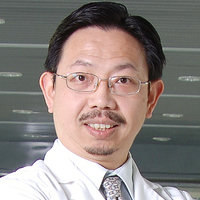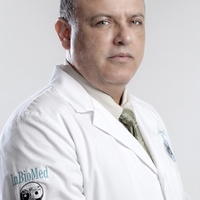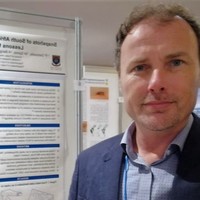
郭集慶 Victor C Kok
Dr. Victor C. Kok is the medical director of Kuang Tien General Hospital Cancer Center, Taichung, Taiwan. He obtained his MD and MMedSc degrees from Chung Shan Medical University, Taiwan, and a Ph.D. from the Department of Biomedical Informatics at Asia University Taiwan. Victor Kok trained as a medical oncologist at the Sun Yat-Sen Cancer Center, Taipei. He was board-certified in the Medical Oncology Certification Exam at the European Society for Medical Oncology and Taiwan Oncology Society. He pioneered the medical oncology program at Changhua Christian Hospital, Changhua, Taiwan. After that, he joined Asia University as an assistant professor. Dr. Kok graduated from the Harvard Medical School High-Impact Cancer Research-Cancer Biology and Therapeutics Program 2018/2019, Boston, Massachusetts. Dr. Kok has been awarded Fellow of the American College of Physicians (FACP) and is now an active member of the American Association for Cancer Research (AACR), the Japan Cancer Association (JCA), the Taiwan Society of Internal Medicine, and the Taiwan Oncology Society. VC Kok's research interests include clinical cancer research, cancer epidemiology, bioinformatics, medical oncology, internal medicine, palliative care, and clinical and population-based disease informatics. He is now an associate editor for Cancer Medicine (WILEY) and an editorial board member for the flagship journal, BMC Medicine.
Phone: +886.4.2662.5111 ext. 2263
Address: Kuang Tien General Hospital Cancer Center
117 Shatien Road Shalu
Taichung 43303 Taiwan
Phone: +886.4.2662.5111 ext. 2263
Address: Kuang Tien General Hospital Cancer Center
117 Shatien Road Shalu
Taichung 43303 Taiwan
less
Related Authors
Rakesh Biswas
University Of Kolkata
Anna M. Czarnecka
Medical University of Warsaw
Prof. Mohamed Labib Salem
Tanta University
Richard Sullivan
King's College London
Trias Mahmudiono
Universitas Airlangga
Michael J. Gonzalez
Universidad de Puerto Rico Rio
Dr. Gary Kao
University of Pennsylvania
Eszter Banffy
Hungarian Academy of Sciences
Peter Delobelle
University of Cape Town
Fernando Godayol
Universidad Central de Venezuela
InterestsView All (11)









Uploads
Videos by 郭集慶 Victor C Kok
Cancer Epidemiology by 郭集慶 Victor C Kok
and 3,594 men with clinical benign prostatic hyperplasia (BPH), matched by similar criteria were assembled. A Cox model was constructed to calculate the adjusted hazard ratio (aHR) after controlling for age, socioeconomic factors, and various medical comorbidities. During the 11,449 person-year follow-up for the ED group, 24 incident prostate cancer developed. During the 44,486 and 11,221 person-year follow-up for the GENPOP and the BPH group, respectively, there were 33 and 25 incidents of prostate cancer. The ED group demonstrated a 2.6-fold greater risk of prostate cancer than that by the GENPOP with an aHR of 2.63 (95% confidence interval [CI] [1.51, 4.59], p < .001). There was no significant difference in risk between ED and BPH group (aHR = 0.83, 95% CI [0.46, 1.48]). This concurrent, double comparison, longitudinal study revealed a positive association between ED and subsequent prostate cancer incidence.
Recent studies report a link between endometriosis and ovarian cancer (OC). Using a population-based cohort study to confirm the association between endometriosis and cancer is desirable. We thus examined the magnitude of the risks of OC, endometrial cancer (EC), breast cancer, colorectal cancer (CRC), and other cancers in women with newly diagnosed endometriosis or adenomyosis (internal endometriosis).
METHODS/MATERIALS:
Women older than 20 years with claims data between 2003 and 2005 were identified from the Longitudinal Health Insurance Dataset containing 1 million individuals randomly sampled from the National Health Insurance Research Database. Those with preexisting malignancies, hysterectomy, or oophorectomy were excluded. The endometriosis cohort (n = 2266, including 768 cases of pure adenomyosis) and comparison cohort (n = 9064), formed by 1:4 matching, were followed up until incidence cancer, dropout, or December 31, 2008. Outcome measures included cancer incidence and adjusted hazard ratio by Cox model adjusted for age group, comorbidities, and endometriosis medication use.
RESULTS:
With 9842 person-years of follow-up in endometriosis cohort and 36,274 person-years of follow-up in comparison cohort, there were increased risks of all cancers (adjusted hazard ratio, 1.8; 95% confidence interval, 1.4-2.4), OC (4.56, 1.72-12.11), and EC (4.05, 1.20-13.66). The ovarian endometriosis group was associated with increased risk of subsequent OC (4.37, 1.07-17.83). The adenomyosis group was strongly associated with both OC (5.50, 1.95-15.50) and EC (5.13, 1.36-19.40). Increased risk of subsequent CRC was observed in women with adenomyosis with coexistent endometriosis at other sites (13.04, 2.21-77.04). However, no statistically significant increased risk of breast or other cancers was observed.
CONCLUSIONS:
Having limitations such as lacking of parity information which may affect the magnitude of risk estimates, this study demonstrates that ovarian endometriosis has a 4-fold increased risk of OC. Adenomyosis may associate with a 4- to 5-fold increased risk of OC and EC, and unexpectedly, a 13-fold increased risk of CRC.
To investigate the association and magnitude of risk between JIA, its associated treatment and cancer development in Taiwanese children.
Methods
Nationwide population-based 1:4 age- and gender-matched retrospective cohort study was designed using the National Health Insurance Research Database of Taiwan. A cohort of 2,892 children <16 years old with JIA was formed as well as a non-JIA cohort of 11,568 in year 2003 to 2005. They were followed up till a diagnosis of malignancy or up to 8 years until 2010. Relative risk (RR), incidence rate ratio (IRR), and adjusted hazard ratio (aHR) of developing malignancy were calculated.
Results
The female to male ratio was 0.79:1. There were 3 cases of incident cancer in the “MTX use, biologics-naïve” group, only 1 in the anti-TNF biologics-containing group and 29 in the “both MTX- and biologics-naïve” group, in comparison, there were 50 cases of cancer in the non-JIA comparator group. During a 16114.16 patient-years follow-up, the RR and IRR for developing a malignancy in both methotrexate- and anti-tumor necrosis factor (TNF) biologics-naïve JIA children were 2.75 (95% confidence interval, 1.75 – 4.32) and 3.21 (2.01 – 5.05), respectively. For leukemia, the IRR was 7.38 (2.50 – 22.75); lymphoma, 8.30 (1.23 – 69.79); and soft tissue sarcoma, 11.07 (0.84 – 326.4). The IRR of other cancers was 2.08 (1.11 – 3.71). The aHR on cancer risk was 3.14 (1.98 – 4.98) in methotrexate- and biologics-naïve group. There were no statistically significant increased risk in JIA patients treated with methotrexate and/or anti-TNF biologics.
Conclusions
Compared with children without JIA, children with JIA have 3-fold increase of risk on malignancy in East Asia. Seemingly neither methotrexate nor anti-TNF biologics increases the risk further.
Methods: We identified a cohort of patients with type 2 diabetics aged $30 years receiving hypoglycemic monotherapy (n=7,325) from the 1998–2007 Longitudinal Health Insurance Dataset. Patients were grouped according to the antidiabetic therapy they received into metformin (n=2,223), sulfonylurea (n=3,965), glitazone (n=53), meglitinide (n=128), acarbose (n=150), and insulin (n=806) groups. Patients with preexisting cancer were excluded. All patients were followed up until cancer development, dropout, death, or until December 31, 2008. Cox’s model was used to estimate multivariable hazard ratios (HRs) adjusted for age, sex, Charlson comorbidity index, smoking-related comorbidities, alcohol use disorders, morbid obesity, pancreatitis, hypertension, monthly income, and urbanization level. The log-rank test was used to compare cumulative cancer incidence. Two-sided P-values ,0.05 were required to reject the null hypothesis.
Results: The overall median follow-up duration was 2.5 years (interquartile range, 3.6 years). Totally, 367 and 124 cancers developed in the sulfonylurea and metformin groups, respectively, representing an adjusted HR of 1.36 (95% confidence interval [CI], 1.11–1.67; P,0.005). No significant differences were observed between other groups. Increased adjusted HRs were observed for colorectal cancer (adjusted HR, 1.94; 95% CI, 1.15–3.27; P,0.05) and lung cancer (adjusted HR, 1.76; 95% CI, 1.00–3.07; P,0.05).
Conclusion: Metformin monotherapy may be associated with a reduction in the risk for cancer development compared with sulfonylurea monotherapy. Moreover, the use of an average defined daily dose of .0.25 of metformin when compared to lower dose will contribute to a reduction of 80% risk.
Methods: We used a population-based cohort study between 2001 and 2008 with appropriate person-time analysis. Participants were followed up until the first incident of cancer, death, or to the end of 2008. The Cox model was used to derive an adjusted hazard ratio (aHR) for cancer development. Kaplan–Meier cancer-free survival curves of two groups were compared.
Results: The exposed group of 2,117 regular ICS users and the nonexposed group of 17,732 non-ICS users were assembled. After 7,365 (mean, 3.5 years; standard deviation 2.1) and 73,789 (mean, 4.1 years; standard deviation 2.4) person-years of follow-up for the ICS users and the comparator group of non-ICS users, respectively, the aHR for overall cancer was nonsignificantly elevated at 1.33 with 95% confidence interval (CI), 1.00–1.76, P=0.0501. The Kaplan–Meier curves for overall cancer-free proportions of both groups were not significant (log-rank, P=0.065). Synergistic interaction of concurrent presence of regular ICS use was conducted using “ICS-negative and chronic obstructive pulmonary disease (COPD)-negative” as the reference. The aHR for the group of “ICS-positive, COPD-negative” did not reach statistically significant levels with aHR at 1.38 (95% CI, 0.53–3.56). There was a statistically significant synergistic interaction of concurrent presence of regular ICS use and COPD with aHR at 3.78 (95% CI, 2.10–6.81).
Conclusion: The protective effect of regular ICS use in the studied East Asian patients with adult-onset asthma was not detectable, contrary to reports of previous studies that ICS might prevent the occurrence of future cancer.
Oncology by 郭集慶 Victor C Kok
We describe a subgroup analysis assessing the efficacy and safety of ramucirumab monotherapy in East Asian (EA) patients from the REGARD trial.
METHODS:
Patients with advanced gastric or gastroesophageal junction adenocarcinoma with progressive disease were randomized 2:1 to receive ramucirumab (8 mg/kg) plus best supportive care (BSC) or placebo plus BSC every 2 weeks. Post hoc subset analyses were performed on the EA and non-EA intention-to-treat populations.
RESULTS:
Of 355 intention-to-treat patients, 26 patients from EA were randomized to ramucirumab (n = 18) or placebo (n = 8). Median overall survival was 6.5 months in the ramucirumab arm and 4.8 months in the placebo arm (hazard ratio [HR] 0.69; 95% confidence interval [CI], 0.27-1.82) for EA patients, and 5.2 months in the ramucirumab arm and 3.8 months in the placebo arm (HR 0.78; 95% CI, 0.60-1.02) for non-EA patients. The rate of disease control was numerically higher in ramucirumab patients versus placebo; 61% versus 38% respectively for EA patients, and 48% versus 22% for non-EA patients. The incidence of grade ≥3 treatment emergent adverse events was higher in the ramucirumab arm compared to placebo (39% vs 13%).
CONCLUSION:
Despite limitations, this subgroup analysis suggests that ramucirumab monotherapy improves efficacy outcomes with a tolerable safety profile in EA patients with previously treated advanced gastric cancer.
from population-based cohort studies conducted in East Asians.
Methods: A literature search using medical subject heading terms and Boolean logic in PubMed and MedLine was performed in April 2017. Twenty-two papers reported from East Asia were retrieved for study and data synthesis. Proportional meta-analysis with a random-effects model
was used to synthesize data with 95% confidence intervals (CIs) when appropriate.
Results: Synthesis of data on VTE incidence in the East Asian population (I2 = 76.2%) showed that pooled incidence was 20.3 (95% CI, 11.2–32) per 100,000 person-years. VTE incidence steadily increased with age. Unprovoked VTE accounted for 35% (95% CI, 24%–48%) of all
cases of incident VTE (I2 = 99.7%). The overall cancer risk was significantly higher (2.3-fold) in the VTE cohort than in comparators. Among the patients with unprovoked VTE, approximately
7% had a subsequent cancer diagnosis within 2 years of the first episode of idiopathic VTE. The risk of VTE recurrence was increased in cancer patients (adjusted odds ratio, 1.64; 95% CI, 1.26–1.99). VTE incidence was 9.9 per 1,000 person-years in cancer patients, particularly
in liver, pancreas, and lung cancer patients.
Conclusion: Newly diagnosed VTE incidence is estimated at approximately 4,400 new cases annually in Taiwan and 7,100 in South Korea. Similar to the trend in VTE incidence among the general population, VTE risk in East Asian cancer patients is markedly lessened.
NGS diagnostics is essential for implementing precision
medicine in patients with MBC. Even when a mutation is
not currently actionable, it may become druggable in the
near future because of the fast-evolving technology and
drug development milieu. As to the time and manner of
incorporating NGS molecular results into clinical practice,
it is no longer a question of why, but instead when and how
to interpret the NGS results which may be a game-changer
in the management of patients with MBC.
(C)2016International Society of Gynecological Pathologists
方法:參考美國退伍軍人部制定之 HFMEA 步驟,就藥事作業流程來定義主題、成立團隊、繪出流程圖、進行危害指數 (hazard score; HS) 評估、決策樹分析與找出失效原因提出改善。
結果:研究期間為2010年4月至2011年9月,從化療給藥流程中找出87項失效模式與147項失效原因進行決策樹分析,最後研擬出12項失效模式與13項失效原因進行改善。在改善措施介入後 (2011年4月1日至9月30日),其醫令疏失率 (0.1278%,3件)與調配疏失率 (0.0426%,1件) 均較去年同期 (2010年4月1日至9月30日) 醫令疏失率(1.4500%,30件) 與調配疏失率 (0.1450%,3件) 明顯下降,其改善幅度分別為91.19%與70.63%,且並未有化療給藥疏失。在進行流程改善後,專案小組將原先的失效模式再進行一次危害指數評量,其危害指數在改善後均下降 (HS ≤ 2分)。
結論:從我們的研究得知,運用 HFMEA 風險管理工具,能有效的改善化療處方、調配和給藥流程,並提升癌症病人用藥安全。
方法:參考美國退伍軍人部制定之 HFMEA,其步驟為定義主題、成立團隊、繪出流程圖、進行危害指數 (hazard score; HS) 評估、決策樹分析與找出失效原因提出改善。
結果:研究期間為2013/1/1至2014/12/31,找出29項失效模式與41項失效原因進行決策樹分析,最後研擬出5項失效模式與8項失效原因 (HS ≧ 8) 進行改善。在改善措施完成後 (2014/4/1-2014/12/31),其化療針劑在效期內施打完成率由改善前 (2013/1/1-2013/3/31) 的95.36%提升到改善後的100%。在進行流程改善後,專案小組將原先的失效原因再進行一次危害指數評量,其危害指數在改善後均下降 (HS ≦ 4)。
結論:在我們的研究得知,運用 HFMEA 風險管理工具,能有效的改善化療針劑在效期內施打完成率,並提升癌症病人用藥安全。
intent established through a multidisciplinary approach
has recently received deserved attention at the prominent
professional oncological conference. For the past decade,
breast oncologists have been bothered by whether the concept of oligometastases was a hypothesis or a reality. Triple‑negative
BC (TNBC) portends a worse prognosis, particularly in women
under the age of 40. Hepatic metastasis from BC carries a very
dismal prognosis and requires multidisciplinary seamless
implementation of an antineoplastic strategy to overcome
the disease. Hepatectomy is often discouraged as an upfront
treatment because of systemic disease consideration.
We report here a case of a young woman who survived our
delivery of personalized multimodal treatment.
Food and Drug Administration in November 2010 and the European Medicines Agency in March 2011 and was reimbursed by the Taiwan National Health Insurance in December 2014 for patients with metastatic breast cancer who had received at least one anthracycline and one taxane. The recommended regimen for eribulin mesylate comprises intravenous administration of 1.4 mg/m2 (equivalent to 1.23 mg/m2 eribulin) over two to five minutes on days 1
and 8 of a three-week cycle. Since 2011, various clinical investigations of eribulin monotherapy with dose or schedule modifications, combined use with other antineoplastic therapeutics, or head-to-head comparisons with specific agents have been performed in the management of advanced breast cancer. Ethnic-specific data from Japan and Korea indicate higher rates (85%) of grade 3 or 4 neutropenia. Some anecdotal evidence suggests that eribulin can shrink brain and retinal metastases, which warrants further detailed studies. In this review, current observations of the effects of eribulin monotherapy are summarized and eribulin-backbone combination (bio-) chemotherapy is investigated.
and 3,594 men with clinical benign prostatic hyperplasia (BPH), matched by similar criteria were assembled. A Cox model was constructed to calculate the adjusted hazard ratio (aHR) after controlling for age, socioeconomic factors, and various medical comorbidities. During the 11,449 person-year follow-up for the ED group, 24 incident prostate cancer developed. During the 44,486 and 11,221 person-year follow-up for the GENPOP and the BPH group, respectively, there were 33 and 25 incidents of prostate cancer. The ED group demonstrated a 2.6-fold greater risk of prostate cancer than that by the GENPOP with an aHR of 2.63 (95% confidence interval [CI] [1.51, 4.59], p < .001). There was no significant difference in risk between ED and BPH group (aHR = 0.83, 95% CI [0.46, 1.48]). This concurrent, double comparison, longitudinal study revealed a positive association between ED and subsequent prostate cancer incidence.
Recent studies report a link between endometriosis and ovarian cancer (OC). Using a population-based cohort study to confirm the association between endometriosis and cancer is desirable. We thus examined the magnitude of the risks of OC, endometrial cancer (EC), breast cancer, colorectal cancer (CRC), and other cancers in women with newly diagnosed endometriosis or adenomyosis (internal endometriosis).
METHODS/MATERIALS:
Women older than 20 years with claims data between 2003 and 2005 were identified from the Longitudinal Health Insurance Dataset containing 1 million individuals randomly sampled from the National Health Insurance Research Database. Those with preexisting malignancies, hysterectomy, or oophorectomy were excluded. The endometriosis cohort (n = 2266, including 768 cases of pure adenomyosis) and comparison cohort (n = 9064), formed by 1:4 matching, were followed up until incidence cancer, dropout, or December 31, 2008. Outcome measures included cancer incidence and adjusted hazard ratio by Cox model adjusted for age group, comorbidities, and endometriosis medication use.
RESULTS:
With 9842 person-years of follow-up in endometriosis cohort and 36,274 person-years of follow-up in comparison cohort, there were increased risks of all cancers (adjusted hazard ratio, 1.8; 95% confidence interval, 1.4-2.4), OC (4.56, 1.72-12.11), and EC (4.05, 1.20-13.66). The ovarian endometriosis group was associated with increased risk of subsequent OC (4.37, 1.07-17.83). The adenomyosis group was strongly associated with both OC (5.50, 1.95-15.50) and EC (5.13, 1.36-19.40). Increased risk of subsequent CRC was observed in women with adenomyosis with coexistent endometriosis at other sites (13.04, 2.21-77.04). However, no statistically significant increased risk of breast or other cancers was observed.
CONCLUSIONS:
Having limitations such as lacking of parity information which may affect the magnitude of risk estimates, this study demonstrates that ovarian endometriosis has a 4-fold increased risk of OC. Adenomyosis may associate with a 4- to 5-fold increased risk of OC and EC, and unexpectedly, a 13-fold increased risk of CRC.
To investigate the association and magnitude of risk between JIA, its associated treatment and cancer development in Taiwanese children.
Methods
Nationwide population-based 1:4 age- and gender-matched retrospective cohort study was designed using the National Health Insurance Research Database of Taiwan. A cohort of 2,892 children <16 years old with JIA was formed as well as a non-JIA cohort of 11,568 in year 2003 to 2005. They were followed up till a diagnosis of malignancy or up to 8 years until 2010. Relative risk (RR), incidence rate ratio (IRR), and adjusted hazard ratio (aHR) of developing malignancy were calculated.
Results
The female to male ratio was 0.79:1. There were 3 cases of incident cancer in the “MTX use, biologics-naïve” group, only 1 in the anti-TNF biologics-containing group and 29 in the “both MTX- and biologics-naïve” group, in comparison, there were 50 cases of cancer in the non-JIA comparator group. During a 16114.16 patient-years follow-up, the RR and IRR for developing a malignancy in both methotrexate- and anti-tumor necrosis factor (TNF) biologics-naïve JIA children were 2.75 (95% confidence interval, 1.75 – 4.32) and 3.21 (2.01 – 5.05), respectively. For leukemia, the IRR was 7.38 (2.50 – 22.75); lymphoma, 8.30 (1.23 – 69.79); and soft tissue sarcoma, 11.07 (0.84 – 326.4). The IRR of other cancers was 2.08 (1.11 – 3.71). The aHR on cancer risk was 3.14 (1.98 – 4.98) in methotrexate- and biologics-naïve group. There were no statistically significant increased risk in JIA patients treated with methotrexate and/or anti-TNF biologics.
Conclusions
Compared with children without JIA, children with JIA have 3-fold increase of risk on malignancy in East Asia. Seemingly neither methotrexate nor anti-TNF biologics increases the risk further.
Methods: We identified a cohort of patients with type 2 diabetics aged $30 years receiving hypoglycemic monotherapy (n=7,325) from the 1998–2007 Longitudinal Health Insurance Dataset. Patients were grouped according to the antidiabetic therapy they received into metformin (n=2,223), sulfonylurea (n=3,965), glitazone (n=53), meglitinide (n=128), acarbose (n=150), and insulin (n=806) groups. Patients with preexisting cancer were excluded. All patients were followed up until cancer development, dropout, death, or until December 31, 2008. Cox’s model was used to estimate multivariable hazard ratios (HRs) adjusted for age, sex, Charlson comorbidity index, smoking-related comorbidities, alcohol use disorders, morbid obesity, pancreatitis, hypertension, monthly income, and urbanization level. The log-rank test was used to compare cumulative cancer incidence. Two-sided P-values ,0.05 were required to reject the null hypothesis.
Results: The overall median follow-up duration was 2.5 years (interquartile range, 3.6 years). Totally, 367 and 124 cancers developed in the sulfonylurea and metformin groups, respectively, representing an adjusted HR of 1.36 (95% confidence interval [CI], 1.11–1.67; P,0.005). No significant differences were observed between other groups. Increased adjusted HRs were observed for colorectal cancer (adjusted HR, 1.94; 95% CI, 1.15–3.27; P,0.05) and lung cancer (adjusted HR, 1.76; 95% CI, 1.00–3.07; P,0.05).
Conclusion: Metformin monotherapy may be associated with a reduction in the risk for cancer development compared with sulfonylurea monotherapy. Moreover, the use of an average defined daily dose of .0.25 of metformin when compared to lower dose will contribute to a reduction of 80% risk.
Methods: We used a population-based cohort study between 2001 and 2008 with appropriate person-time analysis. Participants were followed up until the first incident of cancer, death, or to the end of 2008. The Cox model was used to derive an adjusted hazard ratio (aHR) for cancer development. Kaplan–Meier cancer-free survival curves of two groups were compared.
Results: The exposed group of 2,117 regular ICS users and the nonexposed group of 17,732 non-ICS users were assembled. After 7,365 (mean, 3.5 years; standard deviation 2.1) and 73,789 (mean, 4.1 years; standard deviation 2.4) person-years of follow-up for the ICS users and the comparator group of non-ICS users, respectively, the aHR for overall cancer was nonsignificantly elevated at 1.33 with 95% confidence interval (CI), 1.00–1.76, P=0.0501. The Kaplan–Meier curves for overall cancer-free proportions of both groups were not significant (log-rank, P=0.065). Synergistic interaction of concurrent presence of regular ICS use was conducted using “ICS-negative and chronic obstructive pulmonary disease (COPD)-negative” as the reference. The aHR for the group of “ICS-positive, COPD-negative” did not reach statistically significant levels with aHR at 1.38 (95% CI, 0.53–3.56). There was a statistically significant synergistic interaction of concurrent presence of regular ICS use and COPD with aHR at 3.78 (95% CI, 2.10–6.81).
Conclusion: The protective effect of regular ICS use in the studied East Asian patients with adult-onset asthma was not detectable, contrary to reports of previous studies that ICS might prevent the occurrence of future cancer.
We describe a subgroup analysis assessing the efficacy and safety of ramucirumab monotherapy in East Asian (EA) patients from the REGARD trial.
METHODS:
Patients with advanced gastric or gastroesophageal junction adenocarcinoma with progressive disease were randomized 2:1 to receive ramucirumab (8 mg/kg) plus best supportive care (BSC) or placebo plus BSC every 2 weeks. Post hoc subset analyses were performed on the EA and non-EA intention-to-treat populations.
RESULTS:
Of 355 intention-to-treat patients, 26 patients from EA were randomized to ramucirumab (n = 18) or placebo (n = 8). Median overall survival was 6.5 months in the ramucirumab arm and 4.8 months in the placebo arm (hazard ratio [HR] 0.69; 95% confidence interval [CI], 0.27-1.82) for EA patients, and 5.2 months in the ramucirumab arm and 3.8 months in the placebo arm (HR 0.78; 95% CI, 0.60-1.02) for non-EA patients. The rate of disease control was numerically higher in ramucirumab patients versus placebo; 61% versus 38% respectively for EA patients, and 48% versus 22% for non-EA patients. The incidence of grade ≥3 treatment emergent adverse events was higher in the ramucirumab arm compared to placebo (39% vs 13%).
CONCLUSION:
Despite limitations, this subgroup analysis suggests that ramucirumab monotherapy improves efficacy outcomes with a tolerable safety profile in EA patients with previously treated advanced gastric cancer.
from population-based cohort studies conducted in East Asians.
Methods: A literature search using medical subject heading terms and Boolean logic in PubMed and MedLine was performed in April 2017. Twenty-two papers reported from East Asia were retrieved for study and data synthesis. Proportional meta-analysis with a random-effects model
was used to synthesize data with 95% confidence intervals (CIs) when appropriate.
Results: Synthesis of data on VTE incidence in the East Asian population (I2 = 76.2%) showed that pooled incidence was 20.3 (95% CI, 11.2–32) per 100,000 person-years. VTE incidence steadily increased with age. Unprovoked VTE accounted for 35% (95% CI, 24%–48%) of all
cases of incident VTE (I2 = 99.7%). The overall cancer risk was significantly higher (2.3-fold) in the VTE cohort than in comparators. Among the patients with unprovoked VTE, approximately
7% had a subsequent cancer diagnosis within 2 years of the first episode of idiopathic VTE. The risk of VTE recurrence was increased in cancer patients (adjusted odds ratio, 1.64; 95% CI, 1.26–1.99). VTE incidence was 9.9 per 1,000 person-years in cancer patients, particularly
in liver, pancreas, and lung cancer patients.
Conclusion: Newly diagnosed VTE incidence is estimated at approximately 4,400 new cases annually in Taiwan and 7,100 in South Korea. Similar to the trend in VTE incidence among the general population, VTE risk in East Asian cancer patients is markedly lessened.
NGS diagnostics is essential for implementing precision
medicine in patients with MBC. Even when a mutation is
not currently actionable, it may become druggable in the
near future because of the fast-evolving technology and
drug development milieu. As to the time and manner of
incorporating NGS molecular results into clinical practice,
it is no longer a question of why, but instead when and how
to interpret the NGS results which may be a game-changer
in the management of patients with MBC.
(C)2016International Society of Gynecological Pathologists
方法:參考美國退伍軍人部制定之 HFMEA 步驟,就藥事作業流程來定義主題、成立團隊、繪出流程圖、進行危害指數 (hazard score; HS) 評估、決策樹分析與找出失效原因提出改善。
結果:研究期間為2010年4月至2011年9月,從化療給藥流程中找出87項失效模式與147項失效原因進行決策樹分析,最後研擬出12項失效模式與13項失效原因進行改善。在改善措施介入後 (2011年4月1日至9月30日),其醫令疏失率 (0.1278%,3件)與調配疏失率 (0.0426%,1件) 均較去年同期 (2010年4月1日至9月30日) 醫令疏失率(1.4500%,30件) 與調配疏失率 (0.1450%,3件) 明顯下降,其改善幅度分別為91.19%與70.63%,且並未有化療給藥疏失。在進行流程改善後,專案小組將原先的失效模式再進行一次危害指數評量,其危害指數在改善後均下降 (HS ≤ 2分)。
結論:從我們的研究得知,運用 HFMEA 風險管理工具,能有效的改善化療處方、調配和給藥流程,並提升癌症病人用藥安全。
方法:參考美國退伍軍人部制定之 HFMEA,其步驟為定義主題、成立團隊、繪出流程圖、進行危害指數 (hazard score; HS) 評估、決策樹分析與找出失效原因提出改善。
結果:研究期間為2013/1/1至2014/12/31,找出29項失效模式與41項失效原因進行決策樹分析,最後研擬出5項失效模式與8項失效原因 (HS ≧ 8) 進行改善。在改善措施完成後 (2014/4/1-2014/12/31),其化療針劑在效期內施打完成率由改善前 (2013/1/1-2013/3/31) 的95.36%提升到改善後的100%。在進行流程改善後,專案小組將原先的失效原因再進行一次危害指數評量,其危害指數在改善後均下降 (HS ≦ 4)。
結論:在我們的研究得知,運用 HFMEA 風險管理工具,能有效的改善化療針劑在效期內施打完成率,並提升癌症病人用藥安全。
intent established through a multidisciplinary approach
has recently received deserved attention at the prominent
professional oncological conference. For the past decade,
breast oncologists have been bothered by whether the concept of oligometastases was a hypothesis or a reality. Triple‑negative
BC (TNBC) portends a worse prognosis, particularly in women
under the age of 40. Hepatic metastasis from BC carries a very
dismal prognosis and requires multidisciplinary seamless
implementation of an antineoplastic strategy to overcome
the disease. Hepatectomy is often discouraged as an upfront
treatment because of systemic disease consideration.
We report here a case of a young woman who survived our
delivery of personalized multimodal treatment.
Food and Drug Administration in November 2010 and the European Medicines Agency in March 2011 and was reimbursed by the Taiwan National Health Insurance in December 2014 for patients with metastatic breast cancer who had received at least one anthracycline and one taxane. The recommended regimen for eribulin mesylate comprises intravenous administration of 1.4 mg/m2 (equivalent to 1.23 mg/m2 eribulin) over two to five minutes on days 1
and 8 of a three-week cycle. Since 2011, various clinical investigations of eribulin monotherapy with dose or schedule modifications, combined use with other antineoplastic therapeutics, or head-to-head comparisons with specific agents have been performed in the management of advanced breast cancer. Ethnic-specific data from Japan and Korea indicate higher rates (85%) of grade 3 or 4 neutropenia. Some anecdotal evidence suggests that eribulin can shrink brain and retinal metastases, which warrants further detailed studies. In this review, current observations of the effects of eribulin monotherapy are summarized and eribulin-backbone combination (bio-) chemotherapy is investigated.
研究方法:回溯性分析2014-2015年病人資料進行介入成效比較,營養師以24小時飲食回憶法收集飲食史,主觀資料及客觀資料如體重變化、營養生化指標如白血球、嗜中性白血球及血紅素等,並進行病人營養認知測驗等分析營養介入成效。
結果:2015年頭頸癌18位個案,平均年齡52.7±6.12歲,平均體重61.6±11.1kg,介入期間平均體重流失2.01±5.3 kg(流失比例3.3%),較2014年減少3.3%比例的平均體重流失。介入前熱量攝取1290±732 kcal/day,介入後為1609±402 kcal/day,達成熱量建議人數比率與2014年相比增加11%(從72%增加至83%)。蛋白質介入前攝取46.1±28.4 g/day,介入後63.9±17.0 g/day達統計上顯著差異 (p<0.05),且達建議量人數比率增加26%(從63%增加至89%)。病人營養認知方面發現病人對於如何選擇高蛋白質食物較不清楚 (無法清楚說出富含高蛋白食物,肉魚豆蛋奶類),經營養師介入後,前測成績平均為61.2分,衛教後增加至97.0分達顯著差異 (p<0.05)。
結論:營養衛教有助於病人增加攝食量,進而改善體重流失情形,以及提升病人營養知識,改善營養相關生化值利於維持良好營養狀態。
Methods: This study retrospectively evaluated 243 consecutive patients who received enhanced CT or intravenous pyelography imaging and then underwent abdominal CT imaging within 5 days. According to the interval between imaging, the patients were divided into group A (1 day), group B (2 or 3 days), and group C (4 or 5 days). Three radiologists evaluated CT images to determine GBO. Fisher’s exact test and multivariate backward stepwise elimination logistic regression were performed.
Results: Positive GBO was significantly associated with the interval between imaging studies, contrast type, contrast volume, renal function, and hypertransaminasemia (P<0.05). Multivariate backward stepwise elimination logistic regression analysis of the three groups identified contrast type and hypertransaminasemia as independent predictors of GBO in group B patients (odds ratio [OR], 13.52, 95% confidence interval [CI], 1.72–106.38 and OR, 3.43, 95% CI, 1.31–8.98, respectively; P<0.05). Hypertransaminasemia was the only independent predictor of GBO in group C patients with an OR of 7.2 (95% CI, 1.62–31.73). Hypertransaminasemia was noted in three patients (100%) who initially underwent imaging 5 days prior to GBO.
Conclusion: Delayed GBO on CT imaging may be associated with laboratory hypertransaminasemia, particularly in patients receiving contrast medium over a period of $4 days. A detailed clinical history, physical examination, and further workup are of paramount importance for investigating the underlying cause behind the hypertransaminasemia.
腫瘤細胞並無特定免疫組織學染色特徵,也無特定基因表現型,故在治療上相當棘手。目前公認最好的治療方式為手術切除,不只是有潛在治癒的可能,在已轉移的病人身上也有改善症狀及延長存活期的報告。腫瘤對化學治療反應不佳,而放射線治療則有部份報告指
出可以局部控制疾病,降低局部復發的風險;Mitotane常用於手術後輔助治療、或無法手術者第一線治療、甚至和其他化學治療合併使用,在目前使用報告中,均能有效延後病人復發的時間,也可以增加五年存活率。
Recent studies indicate that chronic insomnia is associated with the development of certain somatic diseases. Whether it would be associated with the development of an autoimmune disease (AID) was unknown.
OBJECTIVE:
We aimed to examine the association and quantify the magnitude of risk for AID in individuals suffering from chronic insomnia requiring sleep-inducing pills.
DESIGN:
This was a population-based, nationwide longitudinal study.
PARTICIPANTS:
Using a claims data set containing 1 million randomly sampled, insured subjects derived from the National Health Insurance Research Database, we assembled a chronic insomnia group and a 1:3 propensity score-matched comparison group (CP), which were balanced in terms of sex, age, insurance premium, urbanization, alcohol use disorder, smoking-related diagnoses, and morbid obesity.
MAIN MEASURES:
Person-time data with incidence rate, adjusted hazard ratios (aHR) by the Cox model, AID-free survival functions compared with the log-rank test, and a sensitivity analysis on the time lag effect were presented. Incident AID within the first year of follow-up were excluded. The error rate was controlled using the Benjamini-Hochberg procedure.
KEY RESULTS:
With 39,550 and 129,914 person-years' follow-up for the chronic insomnia and CP groups (n = 5,736 and 17,208), respectively, we found an increased risk for subsequent AID, representing a 70 % increase in the aHR (1.7; 95 % confidence interval [CI], 1.5-1.9, p < 0.0001). A positive association between chronic insomnia and primary Sjögren's syndrome (pSS) was observed (aHR, 1.3; 95 % CI, 1.1-1.6). Sensitivity analysis disclosed that AID risk was even stronger after 5 years of follow-up (aHR, 2.0; 95 % CI, 1.7-2.4).
CONCLUSION:
Chronic insomnia requiring sleep-inducing pills may be associated with a 70 % increased risk for future AID, particularly pSS.
Methods: Patients aged $40 years with newly diagnosed gout having no pre-existing severe form of CVD were separated into allopurinol (n = 2483) and non-allopurinol (n = 2483) groups after matching for age, gender, index date, diabetes mellitus, hypertension, hyperlipidemia, and atrial fibrillation. The two groups were also balanced in terms of uric acid nephrolithiasis, acute kidney injury, hepatitis, and Charlson comorbidity index.
Results: With a median follow-up time of 5.25 years, the allopurinol group had a modest increase in cardiovascular risk [relative risk, 1.20; 95% confidence interval (CI), 1.08–1.34]. A Cox proportional hazard model adjusted for chronic kidney disease, uremia, and gastric ulcer gave a hazard ratio (HR) for cardiovascular outcomes of 1.25 (95% CI, 1.10–1.41) in gout patients receiving allopurinol compared with the non-allopurinol group. In further analysis of patients receiving urate-lowering therapy, the uricosuric agent group (n = 1713) had an adjusted HR of 0.83 (0.73–0.95) for cardiovascular events compared with the allopurinol group.
Conclusions: The current population-based matched-cohort study did not support the association between allopurinol
therapy in gout patients with normal risk for cardiovascular sequels and beneficial future cardiovascular outcomes. Several important risk factors for cardiovascular disease, such as smoking, alcohol consumption, body mass index, blood pressure were not obtainable in the current retrospective cohort study, thus could potentially bias the effect estimate.
Methods: From September 20, 2013 to September 2, 2014, the hospice palliative care team at a community hospital received 20 consultations for CE. Eight cases were excluded because of non-qualification. Following approval from the Ethics Committee, the medical records of the remaining 12 patients were reviewed and grouped by the underlying disease: A, “terminal-stage cancer”; B, “non-cancer out-of-hospital cardiac arrest”; and C, “non-cancer organ failure”. Time to extubation using a cut-off at 48 hours was assessed.
Results: The mean ages of patients (standard deviation) in groups A, B, and C were 66.3 (14.9) years, 72 (19.1) years, and 80.3 (4.0) years, respectively. The mean number of days of intubation at consultation were 6.8 (4.9), 7.3 (4.9), and 179.3 (271.6), respectively. The mean total doses of opioids (as morphine-equivalent dose) in the 24 hours preceding CE were 76 (87.5) mg, 3.3 (5.8) mg, and 43.3 (15.3) mg. The median times from extubation (range) to death were 97 (0.2–245)
hours, 0.3 (0.2–0.4) hours, and 6.1 (3.6–71.8) hours. Compared to those requiring 48-hour preparatory time, patients requiring 48 hours to the moment of CE were younger (62.8 years vs
75.5 years), required a mean time of 122 hours (vs 30 hours) to CE (P=0.004), had shorter length of stay (33.3 days vs 77.8 days), required specialist social worker intervention in 75% of cases (vs 37.5%), and had a median duration of intubation of 11.5 days (vs 5.5 days).
Conclusion: CE was carried out according to protocol, and the median time from extubation to death varies determined by the underlying disease which was 0.3 hour in patients admitted after out-of-hospital cardiac arrest and 97 hours in patients with advanced cancer.